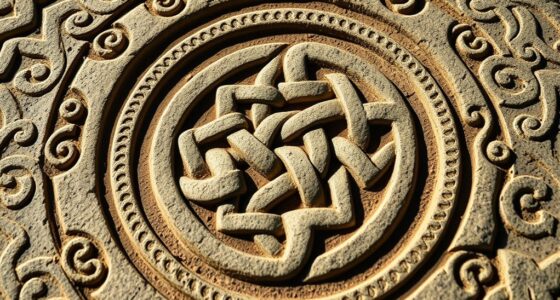You’ll discover that Platonic solids are perfect, highly symmetrical shapes with identical faces, once believed to be the building blocks of matter. These shapes, like the tetrahedron and cube, symbolize fundamental elements and reflect the universe’s intrinsic order. Throughout history, they’ve inspired artists, architects, and scientists, representing harmony, balance, and knowledge. If you keep exploring, you’ll uncover how these shapes connect myth, science, and our understanding of the cosmos.
Key Takeaways
- Historically believed to be the fundamental components of the universe, linking geometry to the natural world.
- Each Platonic solid symbolizes an element: tetrahedron (fire), cube (earth), octahedron (air), dodecahedron (cosmos), icosahedron (water).
- Their perfect symmetry embodies the ancient philosophical idea that these shapes underpin matter’s structure.
- Used in art, architecture, and scientific models to represent universal principles and natural harmony.
- Their mythic and philosophical significance highlights humanity’s quest to understand cosmic order through geometry.

Platonic solids are highly symmetrical three-dimensional shapes that have fascinated mathematicians for centuries. These shapes, composed of faces that are identical regular polygons, exhibit a unique harmony known as geometric perfection. This symmetry isn’t just aesthetically pleasing; it reflects a deep mathematical elegance that has captivated thinkers throughout history. The appeal of platonic solids goes beyond their visual appeal—these shapes hold a significant place in the history of mathematics and philosophy. Their historical significance lies in the way they symbolize the pursuit of understanding the fundamental structure of the universe. Ancient philosophers, such as Plato, believed these solids represented the building blocks of all matter, linking geometry to the cosmos. This connection gave rise to their name, emphasizing their philosophical and scientific importance.
You might find it intriguing that these shapes aren’t just theoretical; they have practical and symbolic applications that stretch across time. The five platonic solids—tetrahedron, cube, octahedron, dodecahedron, and icosahedron—are the only regular polyhedra that exist in three-dimensional space. Each one is characterized by identical faces meeting at identical angles, creating a perfect symmetry that has made them a subject of study for mathematicians and craftsmen alike. Their geometric perfection has been a source of inspiration for artists, architects, and scientists who seek to understand or replicate nature’s harmony. The Greeks, in particular, revered these shapes, believing they encoded fundamental truths about the universe. They associated each solid with elements: earth, air, water, fire, and the cosmos, which underscores their historical significance. Modern research into refrigerant management continues to explore how geometric principles can optimize systems for greater efficiency and environmental sustainability.
As you explore the properties of these solids, you’ll see how their symmetry isn’t just an aesthetic trait but a reflection of nature’s intrinsic order. The way their faces, edges, and vertices align demonstrates a universal pattern that has persisted through centuries. Their mathematical properties, such as their vertices, edges, and face counts, follow strict relationships that reveal the underlying order of space itself. This pursuit of understanding geometric perfection led to important discoveries in mathematics and influenced various fields, from crystallography to art. The enduring legacy of platonic solids lies in their ability to bridge abstract mathematical concepts with tangible, real-world applications. They stand as a testament to humanity’s quest for harmony, balance, and knowledge—an enduring symbol of our desire to decipher the universe’s secrets through geometry.
Frequently Asked Questions
How Do Platonic Solids Relate to Modern Atomic Theory?
You might wonder how platonic solids relate to modern atomic theory. While they don’t directly define atomic structure or molecular geometry, these solids symbolize the idea of perfect, symmetrical forms, inspiring scientists to explore atomic arrangements. Today, understanding atomic structure and molecular geometry helps you grasp how atoms bond and arrange themselves, much like the geometric harmony of platonic solids, which serve as a conceptual foundation for understanding matter’s building blocks.
Are Platonic Solids Used in Contemporary Architecture?
You might notice that platonic solids are still influential in contemporary architecture. Architects use principles of architectural geometry, inspired by these perfect forms, to create innovative designs and structures. In modern design applications, they help develop aesthetically pleasing, structurally sound buildings, especially in projects emphasizing symmetry and harmony. While not always explicitly referenced, the geometric elegance of platonic solids continues to inform creative architectural solutions today.
What Is the Historical Significance of Platonic Solids in Philosophy?
Imagine revealing the universe’s secrets through ancient symbols; that’s what platonic solids represent in philosophy. Their mystical significance lies in embodying perfect harmony and divine order, serving as allegories for the fundamental nature of reality. Philosophical symbolism uses these shapes to explore the cosmos’s structure, inspiring thinkers to seek deeper understanding. You can see how these geometric forms echo humanity’s quest for truth and the sacred, timeless quest for knowledge.
Do All Cultures Recognize the Same Platonic Solids?
You might assume all cultures recognize the same platonic solids, but cultural symbolism and geometric universality vary widely. Some societies see specific shapes as sacred or meaningful, but their recognition of the classical solids isn’t universal. While ancient Greece emphasized these shapes for philosophical reasons, other cultures might interpret geometric forms differently, emphasizing symbolism over strict geometric definitions. So, recognition of platonic solids isn’t consistent across all cultures.
Can Platonic Solids Be Found in Nature?
You might wonder if platonic solids appear in nature. While perfect geometric appearances are rare, natural patterns often resemble these shapes—like mineral crystals and molecular structures. These forms reflect underlying natural patterns that echo the symmetry of platonic solids. Although not exact, these shapes help us visualize how nature employs geometric principles, showing that these solids can indeed be found in the natural world, inspiring both science and art.
Conclusion
So, as you explore the dazzling domain of the Platonic solids, you discover their divine design and mysterious myth. These marvelous, mathematical marvels mold the material world and mirror mythological marvels. By bridging beauty and balance, they beckon you to better understand both the building blocks and the bold stories behind them. Embrace their elegance, explore their essence, and let their timeless truth teach you the thrill of mathematical magic.











